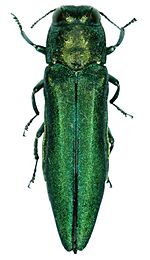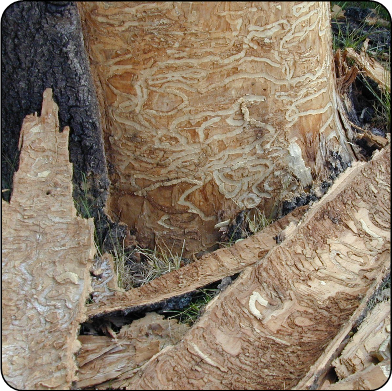Source: Ontario Environment and Energy
 The emerald ash borer was first detected in North America in 2002, but probably arrived on this continent at least a decade earlier. Native to Asia, the beetle has proven to be highly destructive in its new range. Since its arrival, it has killed tens of millions of ash trees and continues to spread into new areas, with considerable economic and ecological impacts.
The emerald ash borer was first detected in North America in 2002, but probably arrived on this continent at least a decade earlier. Native to Asia, the beetle has proven to be highly destructive in its new range. Since its arrival, it has killed tens of millions of ash trees and continues to spread into new areas, with considerable economic and ecological impacts.
Canadian Forest Service (CFS) scientists estimate that costs for treatment, removal and replacement of trees affected by emerald ash borer in Canadian municipalities may reach $2 billion over a 30-year period. Also expected to be significant are the ecological impacts of ash tree mortality on aquatic organisms, birds and understory vegetation, currently under study.
Have your ash trees been affected by the Emerald Ash Borer?
If you live in Welland, Port Colborne, Wainfleet, Fort Erie or anywhere in Southern Niagara and have a tree that you think has has been infested by the Emerald Ash Borer, please don’t hesitate to give us a call at 905-734-5703. Our professionals will come to your location to discuss your options. We are experts regarding ash tree removal and remedies.
Emerals Ash Borer – Overview
- invasive – native to Asia
- the emerald ash borer is an invasive insect that was first discovered in Ontario in June 2002
- the beetle likely crossed into Ontario at Windsor after establishing in the Detroit area, where it probably arrived in wood packaging or pallets
- infestations now exist across much of southern Ontario, from Lambton County north to Grey County and east to Renfrew County and Ottawa; the insect has also been detected on Manitoulin Island, and a separate infestation exists in Sault Ste. Marie and est of the city to St. Joseph’s Island in Algoma District
- the Canadian Food Inspection Agency regulated zone covers a much larger area, which likely has satellite infestations that have yet to be found
“Invasive” refers to a species that has moved outside of its native habitat and threatens the new environment, economy or society by disrupting local ecosystems.
Symptoms and damage
- galleries girdle the ash trees and foliage will wilt or turn yellow
- adults leave “D” shaped exit holes 4 to 5mm across on the bark of infected trees
- shallow meandering “S” shaped tunnels under the bark with abrupt turns
- frass (refuse left behind by boring insects) or sawdust will be evident in tunnels
- tunnelling by larvae girdles the tree cutting off the flow of food and water; branch mortality leads to whole tree mortality and eventually tree death
- epicormic shoots (growing from a previously dormant bud) on branches and trunk
Control measures
Trees can be protected from attack by injecting them with a registered insecticide. Federal regulatory controls restrict the transport of infested ash commodities, including firewood, from infested to non-infested areas.
Host species
Emerald ash borer feeds on all ash (Fraxinus spp.) species in Ontario, including green, red, white, black and blue ash, as well as some non-native species such as European black ash (Fraxinus excelsior).
Species identification and life cycle
- the iridescent metallic green adults emerge in June and July and are 8.5 to 13.5 mm long
- adults have a flattened head, with large black compound eyes on the sides of the head, and short antennae
- eggs are laid one at a time in bark crevices on ash trees, and each female lays between 60 and 90 eggs
- larvae feed by chewing “S” shaped galleries under the bark
- larvae are cream-coloured, 26 to 32 mm long, flattened with a brown head and pincers
- larvae overwinter under the bark and pupate in April or May; adults emerge approximately two weeks later
- in southwestern Ontario, the insect completes its life cycle in one year; however, farther north approximately 30 per cent of the population takes two years
Source: Ontario Environment and Energy



